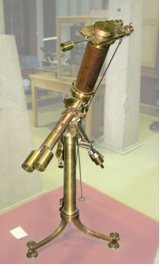- 1610: Galileo
- 1676: Ole Rømer
- 1687: Isaac Newton
- 1781: William Herschel
- 1838: Friedrich Bessel
- 1861: William and Margaret Huggins
- 1912: Henrietta Leavitt
- 1917 Einstein
- 1920: Harlow Shapley
- 1929 Edwin Hubble
- 1948: Ralph Alpher
- 1949: Fred Hoyle
- 1963: Maarten Schmidt
- 1964: Arno Penzias and Robert Wilson
- 1978: Vera Rubin and Kent Ford
- 1989: Margaret Geller and John Huchra
- 1992: John Mather and George Smoot
- 1995: Robert Williams
- 1998: Saul Perlmutter and Brian Schmidt
- 2010: Wendy Freedman
Split Image Telescope
 |
|
Split image telescope. Image courtesy of the Observatory museum, University of Helsinki, Finland.
|
In contrast to Herschel’s huge telescopes, the instrument used by Bessel to measure the separation of two stars was modest in size. That is because the closest stars are bright, so they do not require a large diameter lens or mirror to capture their light. But what it lacked in size, this instrument made up in precision, allowing Bessel to make extremely accurate observations.
The split-image telescope shown at left is a little smaller than the one used by Bessel in 1838 to measure the separation of 61 Cygni and background stars. The main lens is split in two. Each half of the lens forms an image of the two stars to be measured. One of the halves is slid to one side until the image of the background star falls on top of the image of the nearby star. The distance that the lens must be moved is measured precisely and used to find the angular separation of the two stars.